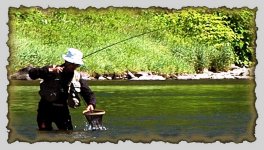I generally use
"The rule of four". Hook size divided by four equals approximate tippet "X" size:
- #12 = 3X
#14 = 3X or 4X
#16 = 4X
#18 = 4X or 5X
#20 = 5X
I've seen recommendations by others who use a very similar formula that yields lighter tippets.
"The rule of three":
- #12 = 4X
#14 = 4X or 5X
#16 = 5X
#18 = 6X
#20 = 6X or 7X
etc.
It might be wise to consider conditions before deciding which way to go. Normal conditions "rule of four". Fussy low clear water conditions "rule of three".
If you release your fish, also consider that a heavier leader will allow you to land and release the fish more quickly, and increase the chances of survival. If conditions allow, any tippet that fits comfortably in the eye of a standard hook should be light enough for a dedicated C&R fisher.

